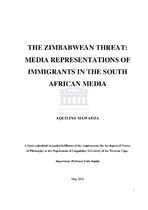| dc.description.abstract | This thesis is a multimodal discourse analysis of the media representations of Zimbabwean immigrants in the South African media. The aim of the investigation is to illustrate how Zimbabwean immigration and Zimbabwean immigrants are portrayed in the print media in South Africa. For the theoretical and analytical framework, the study mainly combines critical discourse analysis (CDA) (Fairclough, 1992, 1995, Van Dijk, 1988, 1991, 1993, Wodak, 1999) and multimodal analysis approaches (Kress and Van Leeuwen, 2006). These approaches are augmented by insights from the cognitive theory of metaphor (Lakoff and Johnson, 1980) and from sociologists such as Stanley Cohen (1972) who have researched on moral panic. The study analyses the coverage of Zimbabwean immigrant stories in the South African print media from the year 2000 to date. A total of five hundred and seventy five articles were randomly selected from the SA Media Database. The SA Media Database is a comprehensive collection of all newspapers published in South Africa. These data are supplemented by articles from newspaper cuttings collected during the course of the study. The focus of the analysis is on how the arrival of Zimbabwean immigrants is ‘problematized’ and transformed into a discursive crisis through the construction of anti-immigrant metaphors and generation of a moral panic. The data are grouped into emerging themes, and data analysis is guided by a multimodal critical discourse analysis approach in which the verbal and visuals are read as text. Although the findings of this study generally support earlier studies which argue that the media representation of Zimbabwean immigrants is negative, the multimodal analysis suggests a more balanced and positive image. Thus, although this study supports studies that show that media discourses represent Zimbabwean immigrants as ‘others,’ and often as criminals, the multimodal analysis of the images of Zimbabwean immigrants suggests that media discourse is much more complex. In the media, the Zimbabwean immigrants are presented as either victims or abusers of the system in South Africa. This reflects a broader discourse on migration which constructs Zimbabweans as ‘aggressors and victims.’ Through discourses of moral panic, the analysis of metaphors, the representation of female immigrants, and the multimodal analysis of language and visual data, this thesis shows an extensive deployment of discursive strategies used for the representation of us and them, characteristic of media discourse on migration. On the other hand, the South African media, through visual images, portrays a sympathetic view toward Zimbabwean immigrants and their difficulties. Thus, while the study supports Woods and King (2001), who note that media discourses represent immigrants as ‘others’ and often as criminals, the multimodal analysis of the images of Zimbabwean immigrants tend to be multivocal, in that they tend to also depict migrants as victims of circumstances beyond their control. Therefore, one conclusion that can be made is that the verbal and visual texts in the South African media do not always tell the same story. In some cases, two or more stories are being told at the same time. The study also concludes that multimodality offers the tools through which the different voices, some of which are contradictory, can be read and heard. Images evoke readers’ schemas and frames of experiences, for instance, of pain and human suffering. In fact, visual images are presented as authentic and objective pieces of evidence, not as representations of reality, but, in a sense, as reality itself (Dauber, 2001).Thirdly, the images of Zimbabwean immigrants convey additional information, beyond the journalist’s intention. With images, readers can quickly elicit a strong emotional response. This is different from a textual description. Therefore, images are not only excellent communicators, but also quickly affect us mentally and emotionally. In this study, for instance, images of Zimbabwean immigrants in long queues at the immigration department enduring cold weather, or bloodied victims of attack, or an image of a helpless Zimbabwean child eating from an empty platter seemingly abandoned and alone, by design or default, draw sympathy from the readers. Because multimodal images tend to tell more than one story, such images can also elicit anger and resentment from the readers.Lastly, this study contributes to our understanding of Zimbabwean immigration to South Africa by focusing on how the media multimodally constructs representations of Zimbabwean immigrants in the South African media. Thus, this study also fills a gap that exists in the study of the interplay between verbal texts and immigration images in the media in African contexts; and specifically contributes to the understudied representations of immigrants in South Africa. Another significant contribution is that this is the only study that has combined cognitive theory of metaphor, the sociological notion of moral panic, critical discourse analysis and current theorization on multimodality to comprehensively account for media representations of immigrants. This study points to the need for a multi-semiotic approach to the analysis of the verbal texts and images of immigration in the South African media for a comprehensive appreciation of the relationship between the verbal and visual texts. | en_US |

